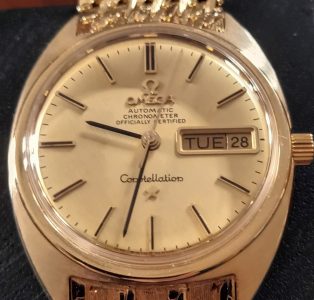I will get the Update out of the way first. As mentioned in earlier posts, I made the decision last November to reduce my watch collection. Three reasons for doing so: Firstly, with in excess of 50 pieces in my collection, I was never going to be able to wear most very much. As such, being imprisoned in my safe seemed, well, rather inhuman! Secondly, simple economics. The twelve or so I earmarked for the initial reduction phase tied up some six figures and, moreover, they were not going to improve in value anytime soon, so, effectively “dead” money. Also, the insurance premium had ballooned. Thirdly, I could no longer actually fit all the watches in my safe – along with other trinkets within!
I consigned the pieces to my pal James Kibble (of Kibble Watches) as I have found him to be the most suited for my purposes. He is, importantly, very trustworthy! To-date four have gone, but alas none of the really tasty ones – despite pretty reasonable prices. I have discussed with James and we may decide to auction some of them in the next few months. However, information for any reader (preferably UK-based) who may be interested in my watches; almost all were bought new by me, so have cast-iron provenance and accompaniments. Also, most were either not worn or barely worn, so of course are in very good condition. Anyway, just go to the Kibble Watches website for full info. The pieces are; 1997 Patek Perpetual calendar 5039J (yellow gold), 2021 Chopard LUC GMT One (rose gold). 2001 Tag Heuer Monaco (yellow gold) and please note – bought NOS from TAG on Oxford St via an employee friend in 2019. 2019 IWC Pilot Spitfire chrono – Bronze with green dial (interesting purchase history). 2020 Cartier Tank Solo XL (rose gold). 1969 Yema Rallye Mario Andretti Chrono. 2020 Muhle 69er (lovely and underrated). 2017 Breitling Transocean 1915 monopusher chrono. Lastly, a really nice quality 1940’s Helvetia (WW2 German Army issue and similar to one of our “Dirty Dozen” types). I am now thinking about selling some more watches. My aim really is to get down to 20 or so – if you believe that!
The rationalization process is of course always going to be hampered by my innate lust for interesting watches! So, it was with some embarrassment that I confess to having now acquired a few more – but today I will reveal the details of just one!
So, its the usual story. I was scanning watch outlet websites, and decided to re-visit Parkers of Sheffield. These were the folks who, if you recall, sold me a decent condition Blancpain box for my Leman chrono I bought last year. I found them friendly and helpful. Anyway, whilst checking out their numerous watches (mainly older Omega and Rolex), my eyes focused on a c1970 Omega Constellation in 18ct. However, the real extra draws included a fantastic Omega gold bracelet, it had it’s original box, and was serviced by Omega in January of this year! The price was up at £6.8k, but after a chat this came down a bit. However, I also did not really want another watch without getting shot of one from the collection. The long and short was that we also did a decent p/ex deal on the newish Omega De Ville Vision I had recently bought at auction. This double benefit is not normally offered, but I guess we just got on so well!
The Constellation duly arrived and I must say I was super impressed. Omega had really done a number on it – mechanically and visually. In fact, along with the service papers, Omega had also returned any changed parts. These comprised of; the crystal, hands, crown and stem, plus several cogs. The only slight shame was over the crown, which was now a slightly different shape – narrower and taller, so not quite as nice as the original – but I suppose this is really just a small nitpick.

Now, I am no real guru on Constellations, but I know that Omega launched them in 1952, further to producing the high-quality Century (100 year anniversary) piece in 1948 – the first limited edition chronometer. Constellations were automatic and self winding via a “bumper” mechanism. All were of chronometer quality too (so at the time, the highest accuracy rating. ED) and until the early 60’s sported the now well-known “pie pan” dial shape. Flat dial options were also available and these slowly took over as fashions changed. To emphasis the quality aspect, the solid case back sported eight stars and an image of the Geneva observatory – representing the eight precision records achieved at Kew/Teddington/Geneva observatories. In the late fifties, the bumper winder gave way to the more reliable and efficient centrally positioned 360 degree rotor that we are familiar with today. In 1964, a more modern “tonneau” case design ensued – probably by design icon Gerald Genta, who was working at Omega then. Due to the overall shape and those integral lugs, it was dubbed the “C” case. However, there were other designs too, such as the TV screen type! The watch was made three metal types – stainless steel, gold plated (capped) and full gold. There were leather straps or bracelet options. Additionally, one could have just a date, or a new option of a day/date, via caliber 751. The watch version looked at today would have been made between 1967-1972, but the “C” case in fact went on to around 1977, covering seven versions. Numerous other Constellation watch designs followed (including quartz, plus slightly smaller versions for ladies) and this continues today.
Now to my specific watch. This is a ref 168.5445/6, and as noted earlier, the serial number indicates a production date of around 1970 (I may try to get a proper Extract from Archive from Omega. Ed), so, is in the middling band of the production window. The watch may have come with the lovely bracelet from new, and if so, is a rarity. I have noticed this bracelet type on earlier gold Pie Pan Constellations (plus a fine mesh version), and moreover when a watch was specified as “Super De Luxe”. Both have the small fold-over clasp with three adjustable positions – a simple mechanism – albeit initially a little fiddly until one gets the hang of it.
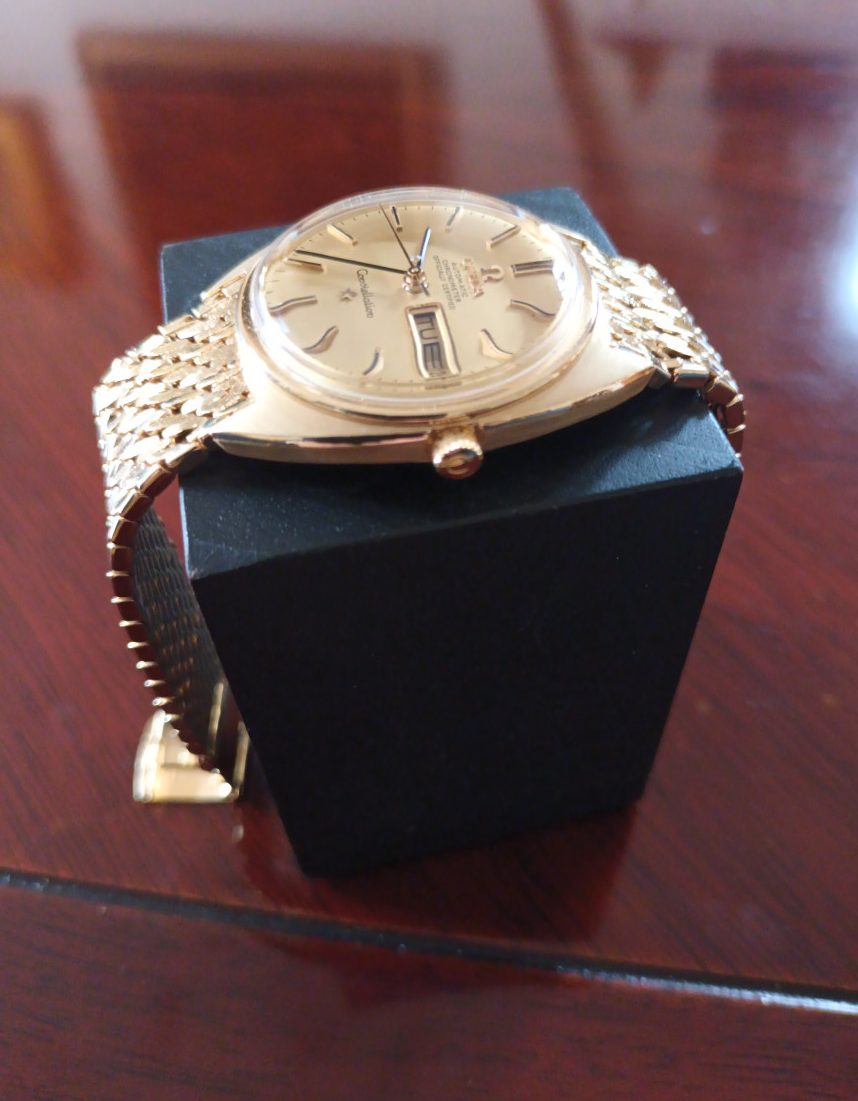
The case therefore is of a tonneau shape, with the integrated lugs following the case shape to almost horn-like points. Although the quoted size is some 34.5mm (and about 12mm thick) it wears larger due to those lugs. The top surface and case sides have fine brushing. However, the thin bezel is polished, as is the fine edge between the case top and sides. The crown is pretty traditional with the Omega sign capping it. As mentioned earlier, the original crown was a little wider and not quite as tall and this suited the watch better. I can only assume that this is no longer available so the servicers simply used the next best thing.
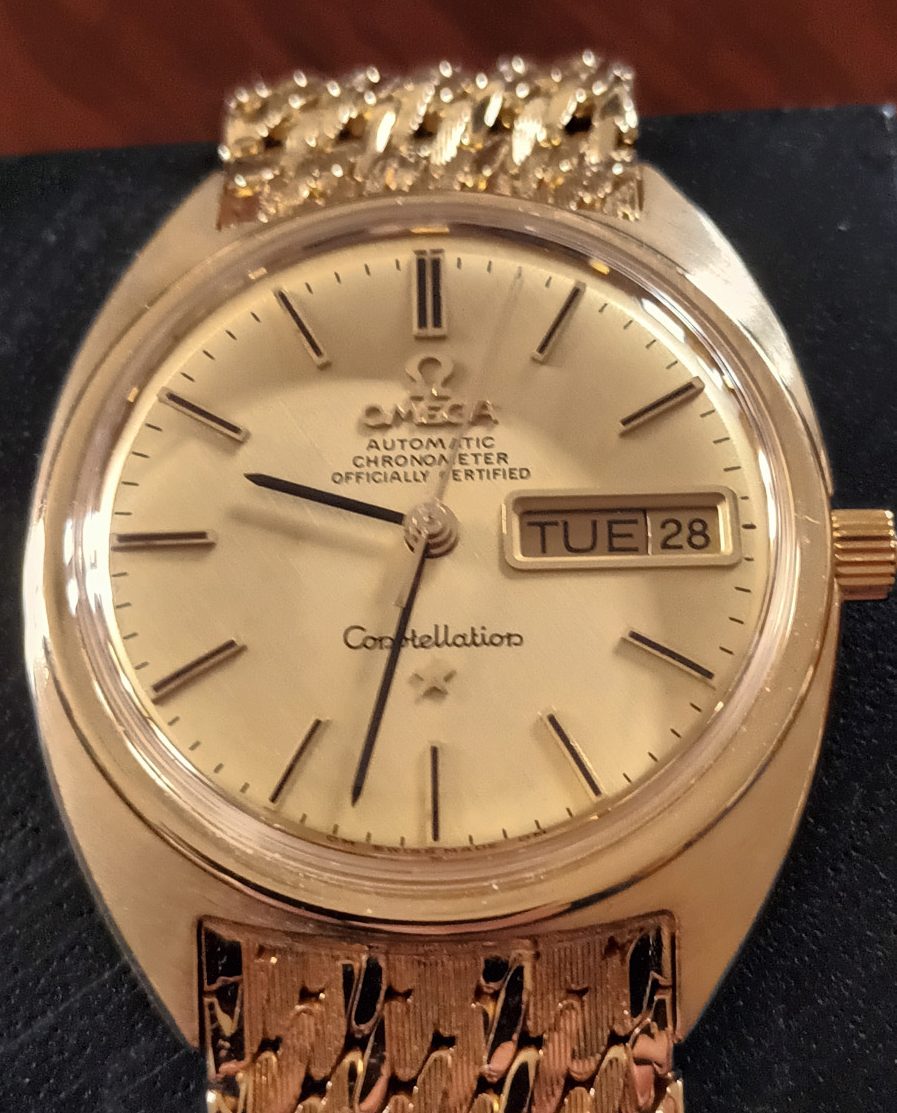
The dial is gold and has very fine brushing. From outboard there is a simple minute rail track in black, then for the hours, applied gold batons with black inserts and for 12 there are two inserts. Also at 12 there is the Omega sign and OMEGA, then the proud statement “Automatic Chronometer Officially Certified”. At 6 is the name Constellation – in neat joined-up writing, and then above, the ubiquitous star. At 3 is the framed day/date window – in Arabic and with a gold background. Lastly, the main hands are simple modest black swords, with the sweep hand being thin in gold. Overall, a neat and legible appearance. There is no lume at all – well, it is a dress watch I guess! The dial is protected, by what I assume would be, an acrylic crystal, of a fairly domed nature.
Turning now to the movement, this is Omega’s inhouse caliber 751, which ran from 1966-1975. It was the first movement to show the day/date and having a quickset for the latter. It was also the first such caliber also to be used in an Omega integrated bracelet watch. The movement boasted 24 jewels, beat at 18,800 vph and, for the day, had a very impressive 50 hour power reserve. Other features included Incabloc shock protection and anti-magnetic properties. As mentioned earlier, the watch was made to chronometer accuracy. I am not sure quite what that would have been then, but these watches when serviced today can achieve readings of a few seconds +/- per day! By the way, I have decided not to open the case back and risk scratching it, so go online if you really want to see that caliber!
Turning the watch over reveals another impressive view – a solid back with the eight stars and the Geneva observatory in relief, all within in a circular disc. The rest of the case is polished and it has six indentations for the unlocking tool.
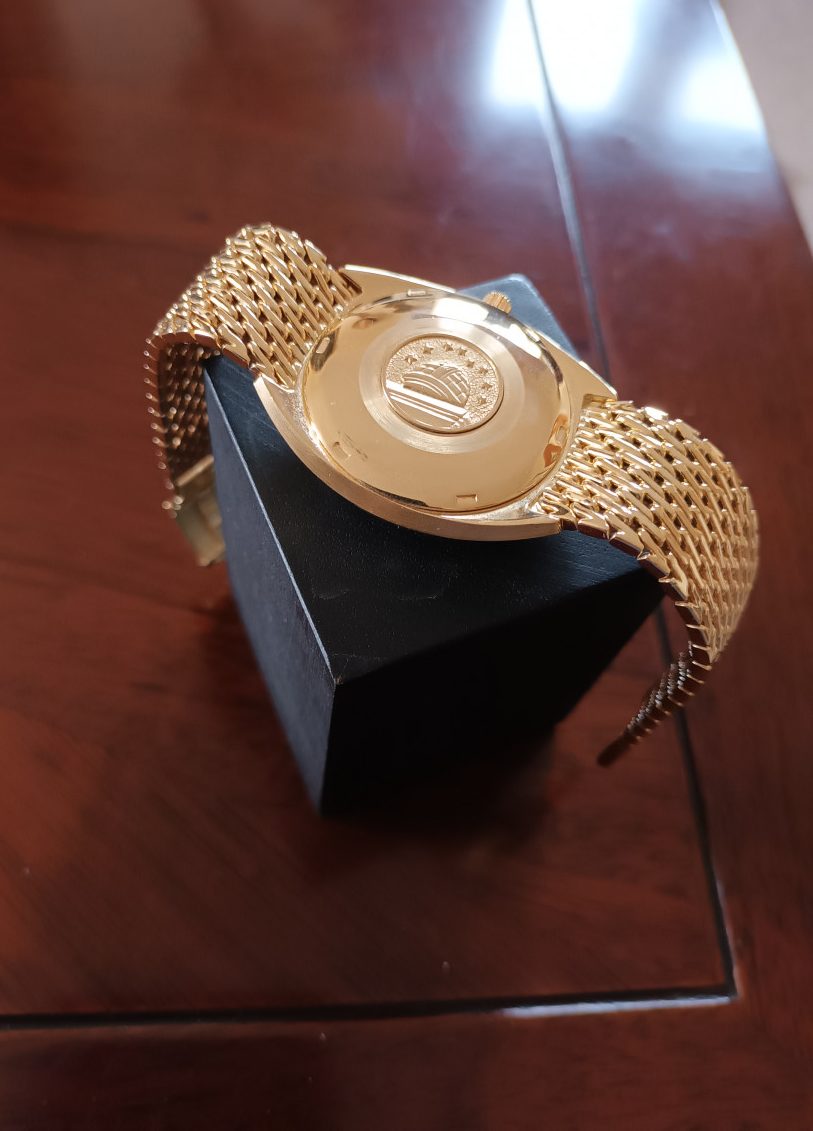
Finally, the bracelet. Frankly, this is one instance where it almost outshines the watch itself! How to describe it? Well, this is not easy as there are several aspects at play, but I will try! Firstly, the bracelet has no links in the traditional sense, as it is constructed more like chain mail. However, the components comprise of tiny lozenge shapes – most of which are engraved with fine lines, and are angled at 45 degrees. These are interspersed with polished versions that run vertically. At the edges are polished “edging” brick designs. The inside of the bracelet has a similar story, but all the lozenges are polished. I have already mentioned the clasp, and it is a really neat and simple piece of kit. All one has to do really is move the square frame end over the clasp, then hook it over the guide bar adjuster, then “winch” closed until a click – and all is secure. There are three possible adjustments – of I suppose a couple of mm each. If this is still too small, then you are goosed really, as attempting to add more lozenges must be impossible now. If too large, then I guess a competent jeweller could to do something, but again, pretty difficult and pricy I expect. So, be sure to check before you buy!
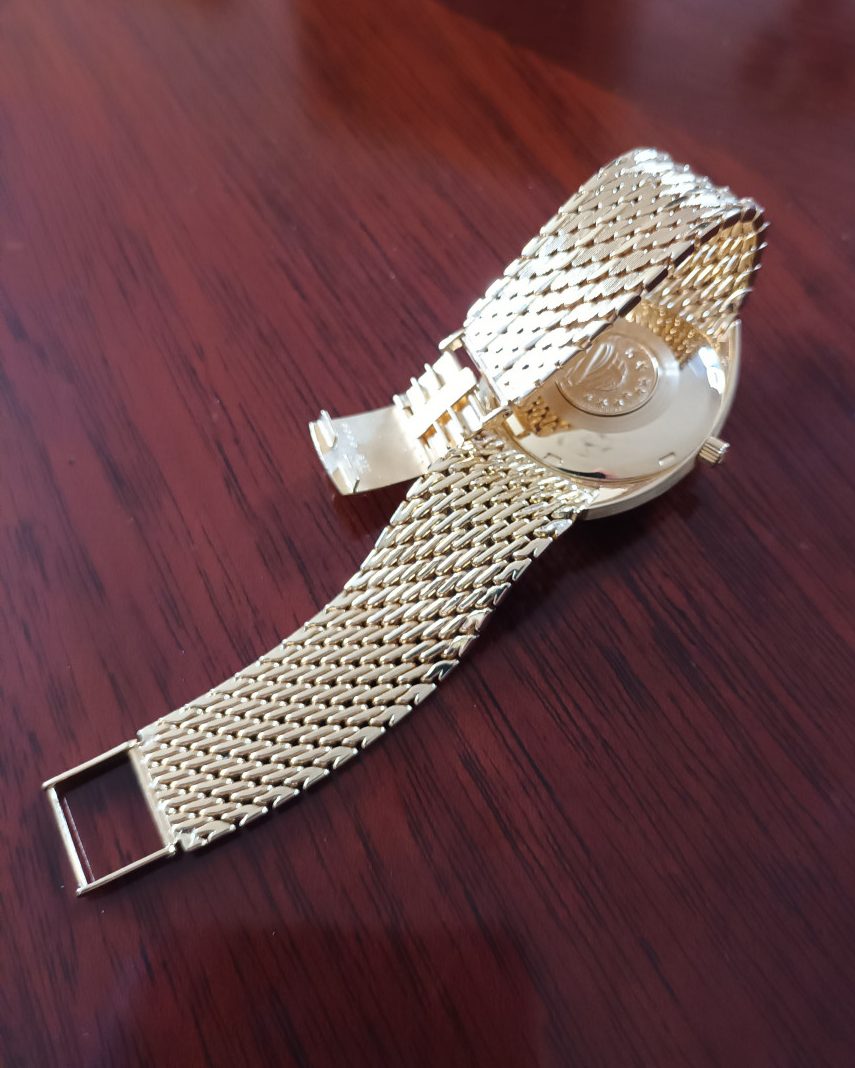
Regarding the service, it would seems that Parkers send most watches back to the brand as a matter of course. On speaking to them, vintage pieces can take up to nine months to do, but that slight negative aside, I was quite impressed with the work and the noted price. As already mentioned, a fair few parts have been changed, but, overall, that does not really bother me. I know that some Rolex owners have been incensed when their watch comes back with new components that then adversely affects the value – a dial/hand change being the most contentious. However, here that is not an issue, and of course internal components may have to be changed if they are worn. I also think that the watch case and bracelet have been chemically cleaned, and then lightly polished – but not to excess. Over the cost, this was noted on the paperwork at some £450 – but I suppose that was the trade price. Most retailers will receive a commission if a customers watch (as opposed to their own stock), and this can add say another 50% or so. However, I am very happy. I have a super vintage watch that has been put back to, really, as new – or pretty close to it. Additionally, I think that for a quality all-gold watch, the net price I paid was pretty reasonable. As such, I thank Parkers for making it happen!
Words/Images: The Writer

